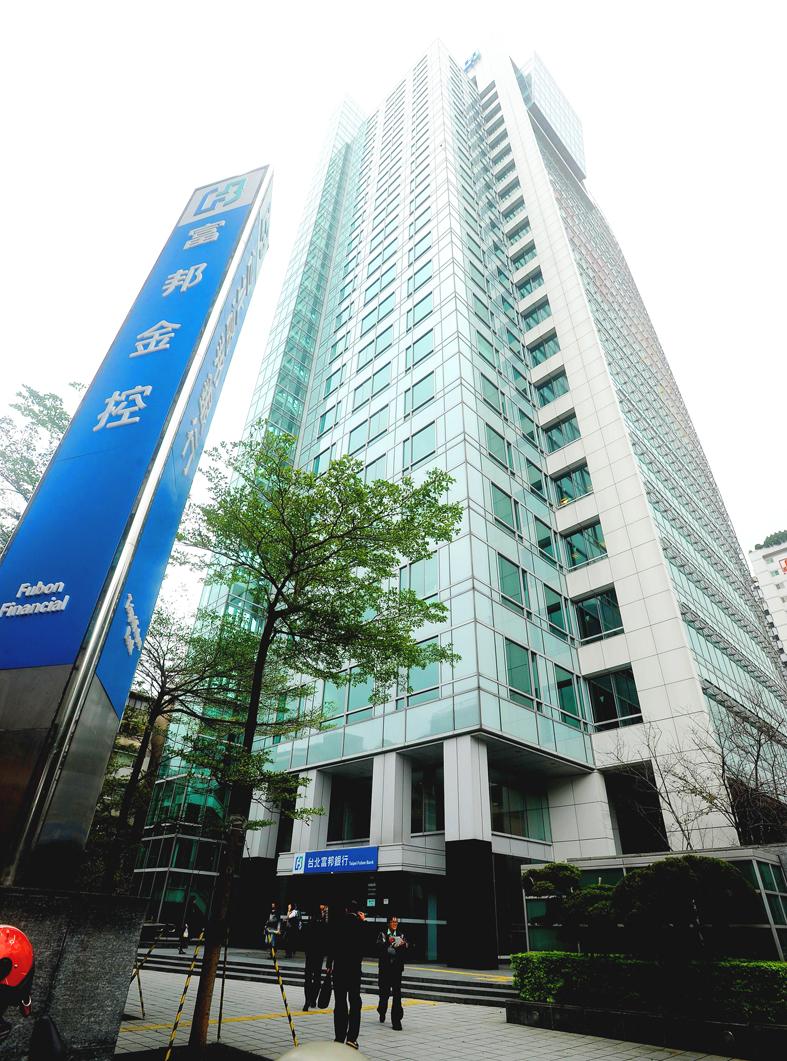The nation’s major financial conglomerates with life insurance subsidiaries have reported higher net profits for the first quarter of this year on the back of investment returns, buoyed by the booming domestic stock market, companies’ data showed.
Fubon Financial Holding Co (富邦金控), the nation’s second-largest financial holding firm by assets, yesterday reported net profit of NT$11.49 billion (US$403.7 million) for last month, up 42 percent year-on-year, while its net profit totaled NT$50 billion in the first quarter, up 118 percent year-on-year, it said in a statement.
Earnings per share were NT$4.89 in the first quarter, ranking the company first among the nation’s 15 financial holdings, it said.

Photo: Lin Cheng-kun, Taipei Times
The company attributed the momentum to its life insurance arm, Fubon Life Insurance Co (富邦人壽), which generated NT$39.11 billion in net profit in the first quarter, up 143 percent from a year earlier.
The insurer took advantage of the thriving local stock market and overseas stock markets to realize capital gains, while it also sold some foreign bonds to book gains and would put the cash back into investments when market rates rise, it said.
“We are upbeat for the domestic stock market, as firms in the electronics sector are solid and the traditional industry is recovering with growing revenue and profit,” Fubon Financial said, adding that it still has a lot of unrealized capital gains, with net value hitting a record NT$520 billion at the end of last month.
Fubon’s results came after Cathay Financial Holding Co (國泰金控) on Saturday reported record net profit of NT$18.09 billion for last month, which led to a record first-quarter profit of NT$57 billion, with earnings per share of NT$4.32, it said in a statement.
Its life insurance unit, Cathay Life Insurance Co (國泰人壽), contributed to the momentum, as net profit at the unit surged 224 percent annually to NT$49.33 billion for the first quarter in light of solid investment returns and good controls over its hedging costs, it said.
Cathay Life Insurance’s market share stood at 21.05 percent for the whole of last year, ranking first among all local life insurers, data compiled by the Financial Supervisory Commission showed.
It was followed by Fubon Life Insurance with a market share of 17.27 percent, Nan Shan Life Insurance Co (南山人壽) with 12.3 percent, China Life Insurance Co (中國人壽) with 8.14 percent and Taiwan Life Insurance Co (台灣人壽) with 6.6 percent, the data showed.
China Development Financial Holding Corp (中華開發金控) in February raised its stake in China Life to 55.95 percent by acquiring another 21.13 percent of China Life’s shares, which enabled the firm to recognize more of China Life’s earnings.
China Development Financial said its first-quarter net profit rose to NT$14.81 billion from NT$1.76 billion a year earlier, aided by the contribution from China Life.
CTBC Financial Holding Co (中信金控), the parent company of Taiwan Life, in a statement said its net profit rose 62 percent to NT$19.7 billion in the first quarter, due to high earnings growth at its life insurance arm.

JITTERS: Nexperia has a 20 percent market share for chips powering simpler features such as window controls, and changing supply chains could take years European carmakers are looking into ways to scratch components made with parts from China, spooked by deepening geopolitical spats playing out through chipmaker Nexperia BV and Beijing’s export controls on rare earths. To protect operations from trade ructions, several automakers are pushing major suppliers to find permanent alternatives to Chinese semiconductors, people familiar with the matter said. The industry is considering broader changes to its supply chain to adapt to shifting geopolitics, Europe’s main suppliers lobby CLEPA head Matthias Zink said. “We had some indications already — questions like: ‘How can you supply me without this dependency on China?’” Zink, who also

The number of Taiwanese working in the US rose to a record high of 137,000 last year, driven largely by Taiwan Semiconductor Manufacturing Co’s (TSMC, 台積電) rapid overseas expansion, according to government data released yesterday. A total of 666,000 Taiwanese nationals were employed abroad last year, an increase of 45,000 from 2023 and the highest level since the COVID-19 pandemic, data from the Directorate-General of Budget, Accounting and Statistics (DGBAS) showed. Overseas employment had steadily increased between 2009 and 2019, peaking at 739,000, before plunging to 319,000 in 2021 amid US-China trade tensions, global supply chain shifts, reshoring by Taiwanese companies and

Taiwan Semiconductor Manufacturing Co (TSMC, 台積電) received about NT$147 billion (US$4.71 billion) in subsidies from the US, Japanese, German and Chinese governments over the past two years for its global expansion. Financial data compiled by the world’s largest contract chipmaker showed the company secured NT$4.77 billion in subsidies from the governments in the third quarter, bringing the total for the first three quarters of the year to about NT$71.9 billion. Along with the NT$75.16 billion in financial aid TSMC received last year, the chipmaker obtained NT$147 billion in subsidies in almost two years, the data showed. The subsidies received by its subsidiaries —

OUTLOOK: Pat Gelsinger said he did not expect the heavy AI infrastructure investments by the major cloud service providers to cause an AI bubble to burst soon Building a resilient energy supply chain is crucial for Taiwan to develop artificial intelligence (AI) technology and grow its economy, former Intel Corp chief executive officer Pat Gelsinger said yesterday. Gelsinger, now a general partner at the US venture capital firm Playground Global LLC, was asked at a news conference in Taipei about his views on Taiwan’s hardware development and growing concern over an AI bubble. “Today, the greatest issue in Taiwan isn’t even in the software or in architecture. It is energy,” Gelsinger said. “You are not in the position to have a resilient energy supply chain, and that,